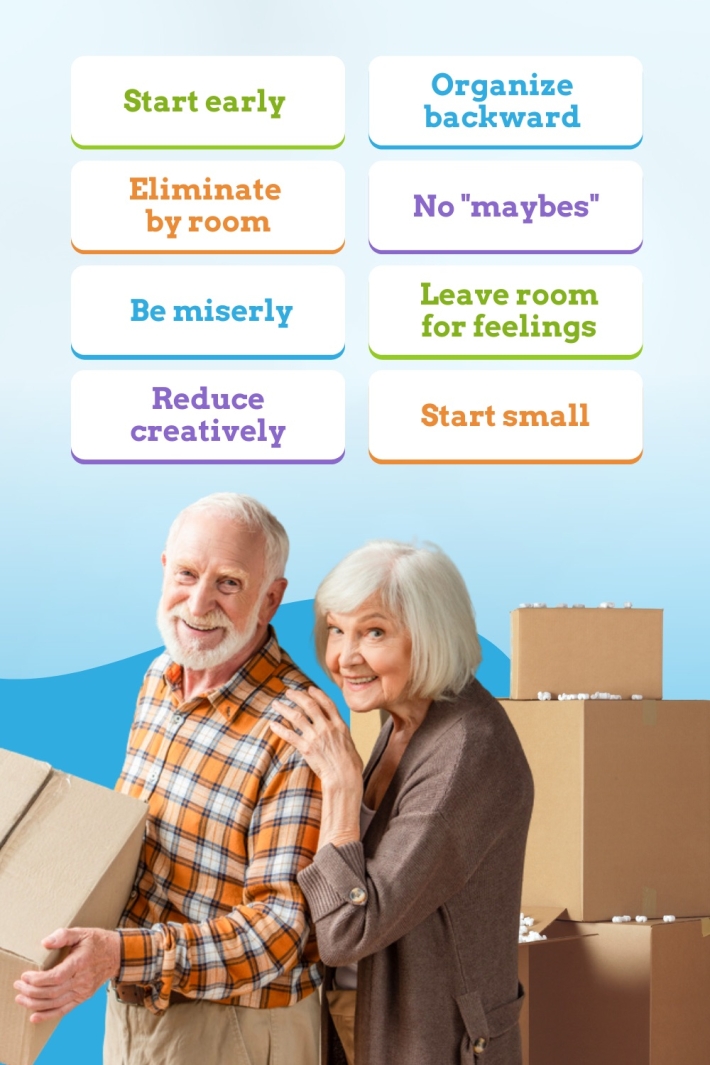8 Tips for Downsizing to a Retirement Community
Downsizing can seem overwhelming, but we walk you through what downsizing is and tips to downsize your home effectively to move to senior living!

Explore:
Most of us are no strangers to decluttering and moving. We’ve likely been through it when we bought a new home or wanted to simplify our lifestyle.
Downsizing to move to a retirement community demands similar time-consuming effort. It can also carry a higher emotional charge. Going through possessions of a lifetime and deciding what to keep or leave behind unleashes a tumult of memory and feelings.
While this is sometimes painful, there’s no need to dread it. Reliving significant memories and sharing them with loved ones can be uplifting and affirming. (Read more about managing the emotions of downsizing. Downsizing is also a good time to intentionally gift meaningful items, ensuring they go to people who’ll treasure them.

Stay Focused and Positive
Choosing to live in a senior living community promises many rewards: a maintenance-provided lifestyle, time for fitness, socialization, lifelong learning, creativity and fun. Stay focused on what you’ll be gaining with the following downsizing tips. They’ll help you overcome common challenges of the downsizing process, putting you in good stead for your upcoming move.
8 Downsizing Tips
- Start early. Giving yourself plenty of time prevents additional stress on top of everything else you might be feeling. Depending on the size of your home and number of rooms, you’ll need several weeks and up to a couple of months to sort through it all. Take it one room at a time and schedule plenty of breaks.
- Start small. Avoid diving into the biggest rooms at the very start. Decluttering a small area with no emotional attachment, such as a laundry room or mudroom, allows you to create a system for sorting, packing and labeling that works for you when you tackle larger rooms. Rooms that are overflow or storage — garages, basements and attics — are harder to work on as they hold the old hobbies, decorations and clutter of years. Leave those till last.
- Organize backward. One approach to downsizing is to pick out what you don’t want and keep the rest. Try doing it the other way around — pack what you want to keep first. Then decide what you’ll do with everything that didn’t make it.
- No “maybes.” This is hard, but it simplifies downsizing if you only have a “yes” and a “no” pile. It’s tempting to create a “maybe” pile, but know that it will inevitably outgrow the others. You’ll eventually be forced to decide what to do with it, and it can be overwhelming. So commit to touching an item only once; either “yes” or “no” and move on.
- Be miserly. Moving isn’t cheap. Do you really want to pay to move something you never use or don’t really like to your new home? If you haven’t used something within the last year or it’s been sitting around because you don’t know what to do with it, it’s not worth your money to take it with you.
- Eliminate by room. Your new home may not have a formal dining room, an office, or a guest bathroom like you do now. Much of what you currently use in these spaces simply won’t fit or won’t be needed. Relocate what’s essential to other rooms and sell or give away the rest.
- Reduce creatively. Some items will tug at your heartstrings. Gifts from your children and other loved ones. Collections you’ve spent years amassing. Put aside the most precious items and take photographs of the rest to place in an album. You’ll enjoy them more without the clutter.
- Leave room for feelings. It’s OK to let your feelings out when you come across an item that holds meaning for you. Old drawings, photographs, mementos and prized possessions are reminders of people and places we love. If it truly brings you happiness, it should go with you.
Are you ready for a move to senior living? This quick 4-minute quiz will help you decide. To help you plan your move, and make sure everything’s in order, you can download free tools, such as a downsizing and moving checklist, home safety checklists, and more.
Where You Live Matters is powered by the American Seniors Housing Association (ASHA), a respected voice in the senior housing industry. ASHA primarily focuses on legislative and regulatory advocacy, research, and educational opportunities and networking for senior living executives, so they can better understand the needs of older adults across the country.
